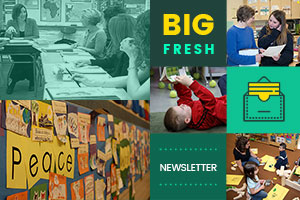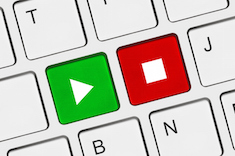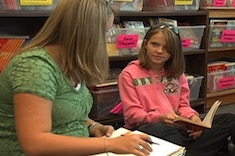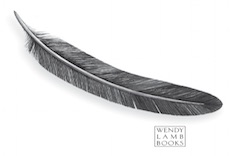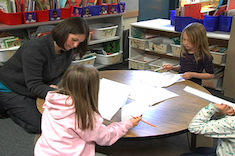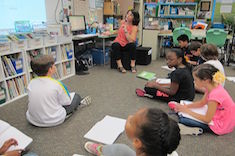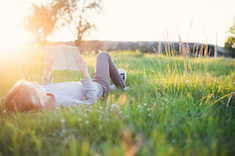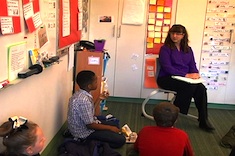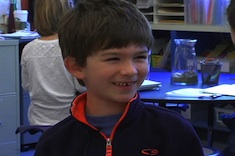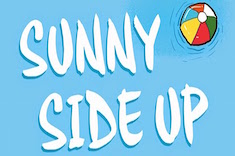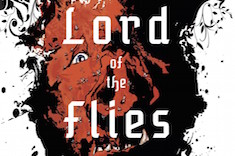Library
Choice Literacy Articles & Videos
The Choice Literacy library contains over 3,000 articles and 900 videos from 150+ contributors. Classic Classroom and Literacy Leadership subscribers have access to the entire library. Content is updated continuously, with five to six new features published each week.
Latest Content
The Big Fresh September 9, 2017 The Penny Project
We look at learning words in this week’s Big Fresh.
Quick Vocabulary Practice and Assessment
Gretchen Schroeder finds that any vocabulary routine eventually gets stale in her high school classroom. She shares a couple of favorite options for reinvigorating word learning.
First-Grade Minilesson: Tricky Words
Bitsy Parks presents a minilesson on figuring out tricky words by recounting a student's strategy from a recent reading conference, using it to begin an anchor chart.
Push Pause: Dealing with Failure in the Midst
Christy Rush-Levine discovers it’s important to “push pause” to deal with failure in the midst of teaching.
Super Teacher Reading Workshop
Mary Lee Hahn tries to be super teacher while she confers — juggling goals, assessments, notices and notes . . . and then it all comes crashing down. She shares what she learns from trying to do too much at once and failing.
The Big Fresh September 2, 2017 Reading the Room
We look at whole-class discussions in this week’s Big Fresh.
Better Reading Partner Shares
Katrina Edwards leads a whole-class reading share session where the focus is on how reading partners work together to teach and not tell.
Balancing Reading and Talk
Mark Levine finds that the best way to deal with controversial topics like slavery in his middle school classroom is with open and focused whole-class discussions.
Writing Share Structures
Katrina Edwards moves her first-grade class out of a rut with writing shares by introducing many new options.
Building a Reflective Community
Andrea Smith builds reflection into whole-class discussions in her fourth-grade classroom by beginning an anchor chart with four different illustrations from the covers of a read-aloud.
Planning for Small-Group Word Study
Stephanie Affinito offers five guiding principles and a template for planning small-group word study.
Sentence Phrase Word: Student Independence for Word Learning
Andrea Smith uses the sentence-phrase-word thinking routine with her fourth graders to show how potent one word can be in understanding complex themes.
Lunchtime Author Discussion Groups
Gigl McAllister explains why she hosts optional lunchtime author studies, with practical tips on getting started.
The Big Fresh August 26, 2017 The Relationship Business
We look at lunchtime, afterschool, and before school literacy activities in this week’s Big Fresh.
Sharing and Celebrating Summer Reading
Tara Barnett and Kate Mills share how they use the first days and weeks of school to celebrate summer reading and build a classroom community.
Fourth-Grade Lunch Fan Club
Gigi facilitates one of her lunchtime author fan clubs, where everyone gets organized and brainstorms what they might explore in the group during this first meeting.
Lunchtime Storytelling
Katrina Edwards dreads lunchtime with her first graders, until she makes a conscious effort to build storytelling skills and share experiences more thoughtfully within the group.
The Big Fresh August 19, 2017 The Way Through
We look at whole-class texts and building community in this week’s Big Fresh.
#bookaday in Middle School: Nuts and Bolts
Jillian Heise shares advice for teachers who want to try a #bookaday challenge of sharing at least one picture book each day with older students. She gives criteria for book selection, as well as examples of books to read at the start of the school year.
Building Community with a Shared Text
Christy Rush-Levine finds a community of new teachers bonds over a text highlighting addiction struggles. The experience leads her to think through what elements are essential for whole-class texts in her middle school classroom.
Connecting Reading and Thinking Minilesson
Bitsy Parks uses read alouds from earlier in September to teach the key building block of comprehension—connections.
When a Book Doesn’t Work
Gretchen Schroeder is frustrated when a novel that has worked well for many years doesn’t appeal to her current high school students. Letting go of it is hard.
The Big Fresh August 12, 2017 Bingo
We look at the role of levels in reading programs in this week’s Big Fresh.
Conferring in First Grade: Reading Illustrations
Katrina Edwards helps a first grader use pictures to help her make sense of confusing text.
The Scarlet Level
Stephanie Affinito tells everyone at a staff meeting to write their weights and ages on sticky notes so that she can post the numbers for the group to view. When teachers balk at the request, she has the perfect opening to discuss why focusing on levels in classrooms is a bad idea.
Leveled Text Dilemma
"We don't have enough leveled texts!" is the cry from teachers. Heather Fisher helps them move beyond the school book room to more creative online resources to meet students' needs, and move beyond narrow definitions of text suitability.
Stuck at Level E
Shari Frost assists a teacher who is instructing a child stuck at level E, and in the process reveals some of the issues in treating all levels equally.
The Big Fresh August 5, 2017 Resolutions for a New School Year
We consider how to launch and sustain writers’ notebooks in this week’s Big Fresh.
Using Stories to Launch Writers’ Notebooks
If you're looking for the perfect launch for writers' notebooks this school year, you might want to begin with story. Tara Barnett and Kate Mills explain how.
Is Writing Essential?
Ruth Ayres shares some of the powerful connections between stories and writing workshops.
Browse Content By
Type
Category
- Assessment Tools
- Big Fresh Archives
- Booklists
- Choice Numeracy
- Classroom Design
- Common Core
- Community Building
- Conferring
- Content Literacy
- Digital Literacy
- English Language Learners
- Equity
- Family Relations
- Free Samples
- Guiding Groups
- Leadership
- Literacy Coaches
- Mentor Texts
- Minilessons
- New Teacher Mentors
- Podcasts
- Poetry
- Quote Collections
- Reading Strategies
- Self Care
- Struggling and Striving Learners
- Talking and Listening
- Teacher Study Groups
- Teaching Reading
- Teaching Writing
- Word Study and Vocabulary
Author
- Melissa Quimby
- Nawal Qarooni
- Gwen Blumberg
- Julie Cox
- The Lead Learners
- Hannah Tills
- Josie Stewart
- Ruth Metcalfe
- Mallory Messenger
- Becca Burk
- Jodie Bailey
- Vivian Chen
- Mary Brower
- Tiffany Abbott Fuller
- Stephanie Affinito
- Ruth Ayres
- Leigh Anne Eck
- Heather Fisher
- Shari Frost
- Julie Johnson
- Suzy Kaback
- Gigi McAllister
- Shirl McPhillips
- Melanie Meehan
- Cathy Mere
- Debbie Miller
- Tara Barnett and Kate Mills
- Tammy Mulligan
- Dana Murphy
- Bitsy Parks
- David Pittman
- Brenda Power
- Heather Rader
- Matt Renwick
- Mandy Robek
- Christy Rush-Levine
- Gretchen Schroeder
- Jen Schwanke
- Brian Sepe
- Katherine Sokolowski
- Stella Villalba
- Jennifer Vincent
Grade Level
Choice Literacy Membership
Articles
Get full access to all Choice Literacy article content
Videos
Get full access to all Choice Literacy video content
Courses
Access Choice Literacy course curriculum and training

